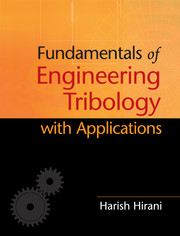Book contents
- Frontmatter
- Dedication
- Contents
- List of Figures
- List of Tables
- Preface
- Acknowledgments
- Nomenclature
- 1 Introduction
- 2 Friction, Wear and Boundary Lubrication
- 3 Lubrication of Bearings
- 4 Hydrodynamic Thrust Bearing
- 5 Hydrostatic and Squeeze Film Lubrication
- 6 Elasto–Hydrodynamic Lubrication
- 7 Gas (Air) Lubricated Bearings
- 8 Mixed Lubrication
- 9 Tribological Aspects of Rolling Motion
- 10 Tribological Aspects of Gears
- Index
- References
9 - Tribological Aspects of Rolling Motion
Published online by Cambridge University Press: 05 March 2016
- Frontmatter
- Dedication
- Contents
- List of Figures
- List of Tables
- Preface
- Acknowledgments
- Nomenclature
- 1 Introduction
- 2 Friction, Wear and Boundary Lubrication
- 3 Lubrication of Bearings
- 4 Hydrodynamic Thrust Bearing
- 5 Hydrostatic and Squeeze Film Lubrication
- 6 Elasto–Hydrodynamic Lubrication
- 7 Gas (Air) Lubricated Bearings
- 8 Mixed Lubrication
- 9 Tribological Aspects of Rolling Motion
- 10 Tribological Aspects of Gears
- Index
- References
Summary
It is known that rolling motion is efficient and preferable to the sliding motion. The concept of rolling motion is applied in all types of wheels, rolling element bearings and various transmission (belt–drive, cam–follower, gears) drives. Rolling motions are often associated with tangential tractions in contact zone (i.e., wheel and its track) or with some degree of slip (i.e., rolling element bearings). In the present chapter, tribo–pairs related to rolling motion, such as rolling element bearings, tyre–road interaction and wheel on rail track have been described. Finally, an analysis of failure of four row cylindrical roller bearing is detailed.
Rolling Element Bearings
The rolling element bearings find applications in auto industry, electric motors, power tools, machine tools, conveyors, escalators, fans, pumps, gyroscope, aircraft, ships, land vehicles, skates, dental drills, etc. There are more than 20000 varieties of rolling bearings (with variations in materials: steel, polymers, ceramics; with and without cage; various types of cages; with or without seal/shield; with and without circlip; single and multi-row; weight: few grams to 50 tonnes). These bearings are often referred to as anti-friction bearings and require relatively less lubricant than that of sliding bearings. In normal lubrication conditions, the friction and wear in rolling element bearings are very low and the bearings have long operational life. However, in the absence of lubrication, tangential and contact stresses increase significantly, both of which shorten the bearing life.
Bearing terminology
There are four main components of a rolling bearing: inner ring, rolling elements, cage and outer ring, as shown in Fig. 9.1. The rolling elements can be balls (Fig. 9.1a), cylindrical rollers (Fig. 9.1b), needle rollers (Fig. 9.1c) tapered rollers (Fig. 9.1d) or spherical rollers (Fig. 9.1e). Generally, needle diameter is much smaller than its length and bearings made of needle rollers are suited for the conditions where radial space is limited. To avoid sliding and collision between rolling elements, rolling elements are arranged in the cage. Cages are generally thin to form a shape to guide the rolling elements. Depending upon the requirement, the cage material can be polymer if the operating temperature is below 60 °C, or can be made of steel coated with molybdenum disulphide, graphite, etc. The rolling element bearings can be made without any cage.
- Type
- Chapter
- Information
- Fundamentals of Engineering Tribology with Applications , pp. 371 - 399Publisher: Cambridge University PressPrint publication year: 2016



